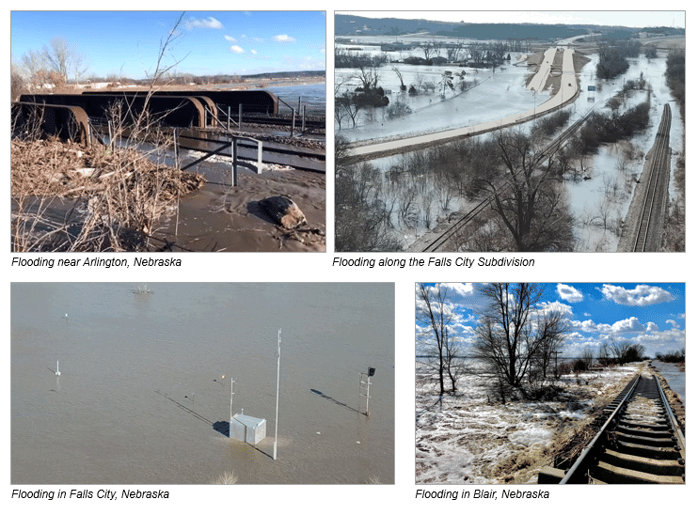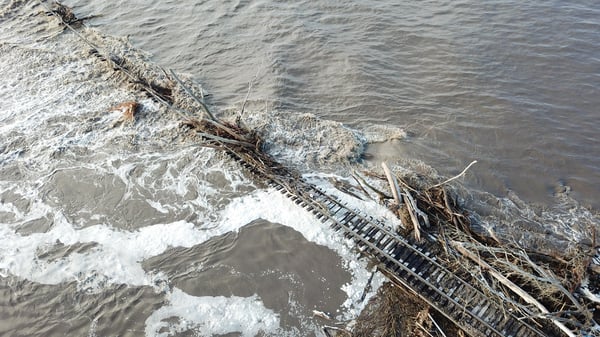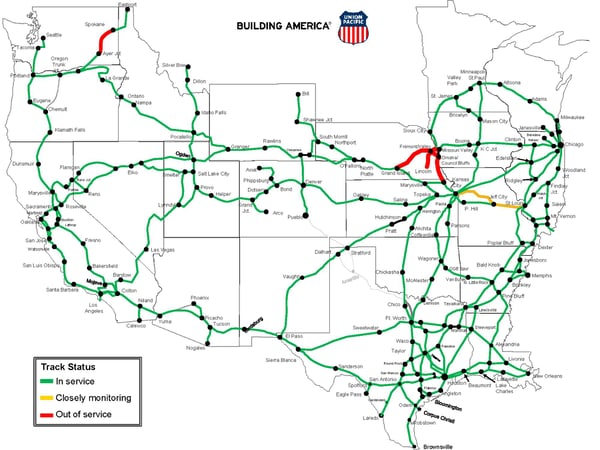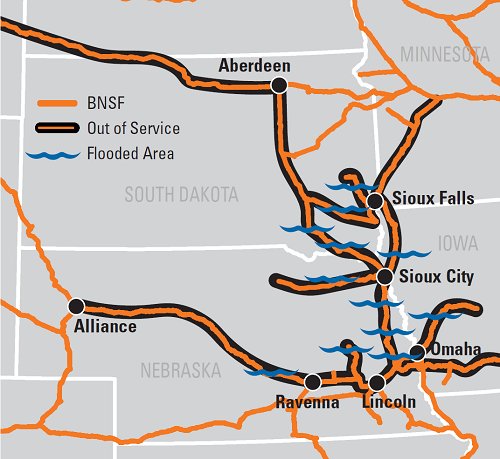Severe flooding halts rail service in the Midwest
- By:
- Kellie Lynch
- Date:
- Mar 21, 2019 10:47:20 AM
- Categories:
- Market Updates, North America, Shipping & Logistics News
Severe flooding caused by melting winter snow and heavy rain has heavily impacted major railways in the Midwest. Rails running through Nebraska, Iowa, Missouri, South Dakota, Minnesota, and Washington have been affected, with the worst conditions being observed in eastern Nebraska (Omaha, Lincoln, & Ravenna) and western Iowa.
BNSF & UP Network Conditions Update
Conditions as of mid-April
Latest update from UP (4/18):
- The rail bridge over the Platte River is estimated to reopen the latter part of May. All local customers in the impacted area are receiving rail service.
- Repairs continue and the route is estimated to re-open this weekend.
- We continue to monitor flood conditions and flood gate closures in the area as water levels are expected to remain elevated through the end of this month.
Latest Update from BNSF (4/26):
Widespread flooding across portions of Nebraska, Iowa and Missouri is causing major disruptions to BNSF service and operations. With recent storms and accelerated snowmelt, which has caused ice jams on area rivers, water levels have reached record high levels.
BNSF crews are working to restore service as quickly as possible. As always, safety is our highest priority. While some traffic is being re-routed, shipments destined for locations in this region will continue to experience delays.
BNSF Outage Map
Record Midwest floods force rail embargoes
Heavy rain and warmer temperatures from a recent winter storm, called a "bomb cyclone", have accelerated snow melt in the Missouri River Valley and contributed to ice jams on area rivers causing historic flooding in many locations.
CNN meteorologist Jennifer Gray explains that a "bomb cyclone" is a rapidly intensifying storm that occurs when cold air from the north combines with warm air blowing in from the gulf stream. Also called "nor'easters", bomb cyclones often bring heavy rains, wind, and snow to the northeastern U.S.
Heavy flooding has resulted in roads, bridges, and rails being washed away. Thousands have been evacuated from low-lying areas as water levels continue to rise. Many people and animals have been trapped by high water, and in some places, whole neighborhoods are underwater.
The National Guard in Nebraska has begun rescuing those trapped by the rising water, and is even using helicopters to airdrop bales of hay to cattle stranded across Nebraska by the flooding, shown in a video posted on their Twitter.
The National Weather Service has urged the public to stay off of the flooded roadways.
Historic flooding continues across the Plains and Midwest this week with many rivers at "major flood" stage. Many roads are closed due to flooding in the region and they're closed for good reason. 50% of all flood deaths are vehicle related. Turn around, don't drown! pic.twitter.com/a557SvaKJj
— NWS (@NWS) March 18, 2019
The photos below from UP and BNSF show the impact of the flooding on the rail systems. Many railways have been washed out and covered with debris. Crews are working diligently to clear the tracks and restore service, however the current extent of the flooding could see service outages continue for an extended period.




“Our goal is to restore service as safely and quickly as we can,” said Shane Keller, UP Senior Vice President - Transportation in an article on the UP website.
“It wouldn't be possible without the hard work of our employees, some of whom have had their houses flooded or are unable to access them. They are working 24/7, utilizing shift work. Many of these employees are the same men and women who have been fighting the snow and winter weather for the past few months. I'm very appreciative of their dedication."
Thank you, from UWL, to the UP team for all of their efforts to work through these conditions.
UP Network Conditions by Subdivision
For the most recent network conditions updates, please visit UP's Flood Recovery Page.
At the time this article was written, the below Union Pacific subdivisions and corridors continue to be out of service due to flooding and track washouts. While in some cases estimated times of opening are listed below, these are subject to change.
Omaha Subdivision (Missouri Valley, Iowa, to Fremont, Nebraska, via Omaha)
- Water remains over portions of the rail.
- Current estimated time of opening is March 22, 2019.
Blair Subdivision (Fremont, Nebraska, to Missouri Valley, Iowa, via Blair)
- Water has receded.
- Debris has been removed and track structure repairs have begun.
- Current estimated time of opening is March 21, 2019.
Columbus Subdivision (Fremont to Grand Island, Nebraska)
- Water remains over portions of the rail.
- Debris has been removed and track structure repairs have begun where water has receded.
- Current estimated time of opening is March 27, 2019.
Lincoln Subdivision (Valley to Lincoln, Nebraska)
- Water has receded.
- Inspections and repairs to be scheduled.
- Current estimated time of opening has yet to be established.
Falls City Subdivision (Council Bluffs, Iowa, to Kansas City, Kansas)
- Water remains over portions of the rail.
- Current estimated time of opening has yet to be established.
Ayer Subdivision (Spokane to Hinkle, Washington)
- Track repair and site clean up are ongoing in relation to the derailment caused by a rock slide. No estimated time of opening is currently available.
Mankato Subdivision Reopens (Minneapolis to Mankato, Minnesota)
- Union Pacific has reopened service over the Mankato Subdivision where previously there was an outage associated with a derailment. Customers should expect continued delays over the next 48 hours as UP begins to move traffic over the previously impacted area.
[Excerpt from UP Announcement CN2019-18]
BNSF Service Expectations
For the most recent network conditions updates, please visit BNSF's Flood Recovery Page.
At the time this article was written, anticipated Mississippi River flooding was expected to impact service on BNSF Hannibal and River Subdivisions, where main lines run adjacent to the river in Missouri. BNSF Heartland Division teams have implemented procedures, including the re-routing of some traffic, to mitigate impacts from this expected disruption.
Favorable operating conditions are expected across the western U.S. during the next several days. With no major storms in the forecast and temperatures at or near normal levels across the Northern Corridor, BNSF operating teams will continue to focus on normalizing service through impacted areas.
Below is a look at the key operational performance categories for the week ending March 14:
Total trains held for the week decreased by more than 17% with an average of 154.1 trains held versus 185.9 trains held during the prior week.
- Versus the March 2018 average: up by 44.7%
Total trains on the system was up by more than 1% versus the prior week with an average of 1,548 trains on the system.
- Versus the March 2018 average: down by 0.8%
Car velocity, measured in miles per day (MPD), was up by more than 2% at 177.3 MPD versus 173.4 MPD recorded the prior week.
- Versus the March 2018 average: down by 17.3%
Train velocity, measured in miles per hour (MPH), was up by nearly 4% versus the prior week at 15.7 MPH.
- Versus the March 2018 average: down by 14.0%
Total volume decreased by nearly 3% from the prior week with 191,474 units moved in Week 10 (ending March 9)
- Versus 196,631 units in Week 9 (ending March 2).
Terminal dwell was down by nearly 3% versus the prior week at 29.1 hours.
- Versus the March 2018 average: up by 13.0%
[Excerpt from BNSF CustomerLetter 03/15/2019]
Network Outage Maps
UP Network Outage Map
(as of 03/18/19)
BNSF Network Outage Map
(as of 03/15/19)
Additional Resources
- UP Network Conditions Update (3/18/19)
- UP Flood Announcement (3/17/19)
- BNSF Customer Letter (3/15/19)
- UP Embargo List
- UP Flood Planning & Recovery
- BNSF Flood Recovery
- Additional Coverage from FreightWaves "Midwest flooding grinds rail service to a halt" by Nick Austin, 3/18/19



